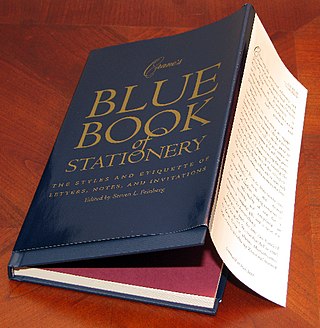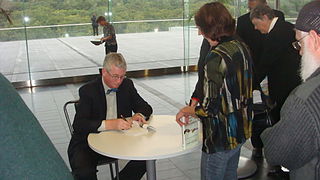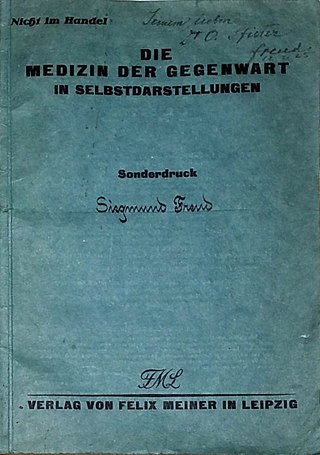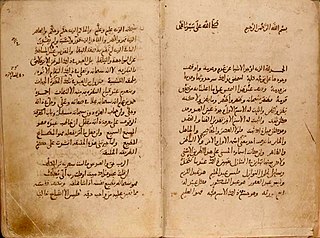
A manuscript was, traditionally, any document written by hand or typewritten, as opposed to mechanically printed or reproduced in some indirect or automated way. More recently, the term has come to be understood to further include any written, typed, or word-processed copy of an author's work, as distinguished from the rendition as a printed version of the same.

An autograph is a person's own handwriting or signature. The word autograph comes from Ancient Greek, and can mean more specifically:

Bibliography, as a discipline, is traditionally the academic study of books as physical, cultural objects; in this sense, it is also known as bibliology. English author and bibliographer John Carter describes bibliography as a word having two senses: one, a list of books for further study or of works consulted by an author ; the other one, applicable for collectors, is "the study of books as physical objects" and "the systematic description of books as objects".

The Gutenberg Bible, also known as the 42-line Bible, the Mazarin Bible or the B42, was the earliest major book printed in Europe using mass-produced metal movable type. It marked the start of the "Gutenberg Revolution" and the age of printed books in the West. The book is valued and revered for its high aesthetic and artistic qualities and its historical significance.

Book collecting is the collecting of books, including seeking, locating, acquiring, organizing, cataloging, displaying, storing, and maintaining whatever books are of interest to a given collector. The love of books is bibliophilia, and someone who loves to read, admire, and a person who collects books is often called a bibliophile but can also be known as an bibliolater, meaning being overly devoted to books, or a bookman which is another term for a person who has a love of books.

Epigraphy is the study of inscriptions, or epigraphs, as writing; it is the science of identifying graphemes, clarifying their meanings, classifying their uses according to dates and cultural contexts, and drawing conclusions about the writing and the writers. Specifically excluded from epigraphy are the historical significance of an epigraph as a document and the artistic value of a literary composition. A person using the methods of epigraphy is called an epigrapher or epigraphist. For example, the Behistun inscription is an official document of the Achaemenid Empire engraved on native rock at a location in Iran. Epigraphists are responsible for reconstructing, translating, and dating the trilingual inscription and finding any relevant circumstances. It is the work of historians, however, to determine and interpret the events recorded by the inscription as document. Often, epigraphy and history are competences practised by the same person. Epigraphy is a primary tool of archaeology when dealing with literate cultures. The US Library of Congress classifies epigraphy as one of the auxiliary sciences of history. Epigraphy also helps identify a forgery: epigraphic evidence formed part of the discussion concerning the James Ossuary.

Mr. William Shakespeare's Comedies, Histories, & Tragedies is a collection of plays by William Shakespeare, commonly referred to by modern scholars as the First Folio, published in 1623, about seven years after Shakespeare's death. It is considered one of the most influential books ever published.

The dust jacket of a book is the detachable outer cover, usually made of paper and printed with text and illustrations. This outer cover has folded flaps that hold it to the front and back book covers.

Book signing is the affixing of a signature to the title page or flyleaf of a book by its author. Book signings are events, usually at a bookstore or library, where an author sits and signs books for a period.

Confessio Amantis is a 33,000-line Middle English poem by John Gower, which uses the confession made by an ageing lover to the chaplain of Venus as a frame story for a collection of shorter narrative poems. According to its prologue, it was composed at the request of Richard II. It stands with the works of Chaucer, Langland, and the Pearl poet as one of the great works of late 14th-century English literature. The Index of Middle English Verse shows that in the era before the printing press it was one of the most-often copied manuscripts along with Canterbury Tales and Piers Plowman.

Poems, Chiefly in the Scottish Dialect, commonly known as the Kilmarnock Edition, is a collection of poetry by the Scottish poet Robert Burns, first printed and issued by John Wilson of Kilmarnock on 31 July 1786. It was the first published edition of Burns' work. It cost three shillings and 612 copies were printed. The volume was dedicated to Gavin Hamilton.

The John Carter Brown Library is an independently funded research library of history and the humanities on the campus of Brown University in Providence, Rhode Island. The library's rare book, manuscript, and map collections encompass a variety of topics related to the history of European exploration and colonization of the New World until circa 1825. The library was the first independent private library placed within the context of a university campus in the United States.

The John Hay Library is the second oldest library on the campus of Brown University in Providence, Rhode Island, United States. It is located on Prospect Street opposite the Van Wickle Gates. After its construction in 1910, the Hay Library became the main library building on campus, replacing the building now known as Robinson Hall. Today, the John Hay Library is one of five individual libraries that make up the University Library. The Hay houses the University Library's rare books and manuscripts, the University Archives, and the Library's special collections.

Thomas James Wise was a bibliophile and thief who collected the Ashley Library, now housed by the British Library, and later became known for the literary forgeries he printed and sold.

The only surviving image that may depict Anne Hathaway, the wife of William Shakespeare, is a portrait line-drawing made by Sir Nathaniel Curzon in 1708, referred to as "Shakespear's Consort". It was probably traced from a lost Elizabethan original. The drawing is currently located in the Colgate University Libraries, Special Collections and University Archives, Hamilton, NY.

Drexel 5856 is a music manuscript containing works composed by George Frideric Handel. It is a significant primary source of the composer's work, having been copied by one of Handel's frequent copyists, John Christopher Smith, possibly as a presentation copy.

A shelfmark is a mark in a book or manuscript that denotes the cupboard or bookcase where it is kept as well as the shelf and possibly even its location on the shelf. The closely related term pressmark denotes only the cupboard or case. It is distinct from a call number, which is the code under which a book or manuscript is registered and which is used to identify it when ordering it. Sometimes a shelfmark or pressmark may be used as a call number, but in other cases the call number contains no information about the book's physical location. In certain American institutions, shelfmark and call number are combined to create a long code containing information on location, classification, size, binding, author and date. Shelfmarks and pressmarks were usually written, inscribed or stamped on the pastedowns. When a book was moved, the old shelfmark was usually crossed out and a new one added. Old shelfmarks can sometimes provide valuable information about a manuscript's provenance.Shelfmarking declined in the 19th century with the rise of classification schemes like Dewey Decimal Classification.

A presentation miniature or dedication miniature is a miniature painting often found in illuminated manuscripts, in which the patron or donor is presented with a book, normally to be interpreted as the book containing the miniature itself. The miniature is thus symbolic, and presumably represents an event in the future. Usually it is found at the start of the volume, as a frontispiece before the main text, but may also be placed at the end, as in the Vivian Bible, or at the start of a particular text in a collection.

An offprint is a separate printing of a work that originally appeared as part of a larger publication, usually one of composite authorship such as an academic journal, magazine, or edited book. Offprints are used by authors to promote their work and ensure a wider dissemination and longer life than might have been achieved through the original publication alone. They may be valued by collectors as akin to the first separate edition of a work and, as they are often given away, may bear an inscription from the author. Historically, the exchange of offprints has been a method of correspondence between scholars.

An autograph or holograph is a manuscript or document written in its author's or composer's hand. The meaning of autograph as a document penned entirely by the author of its content, as opposed to a typeset document or one written by a copyist or scribe other than the author, overlaps with that of holograph.




















